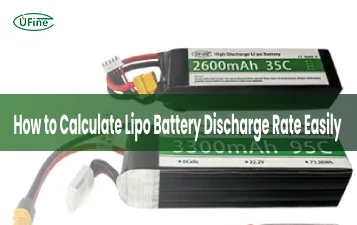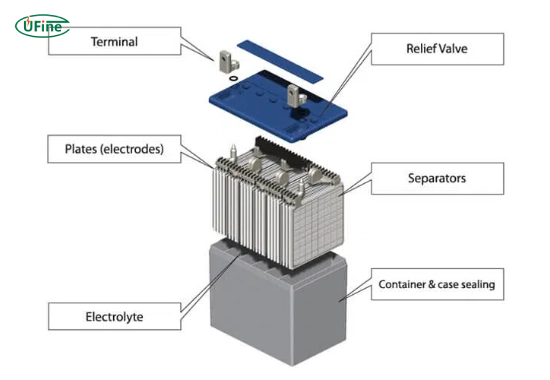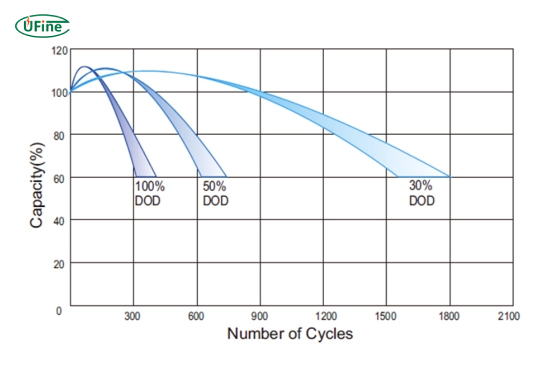In today’s world, where vehicles and gadgets increasingly rely on robust and durable batteries, AGM (Absorbent Glass Mat) batteries are a popular choice. However, one question remains on the minds of many: Do AGM batteries last longer? Understanding the lifespan of these batteries, their advantages, and how to maintain them is essential for making an informed decision. This article dives deep into AGM batteries, exploring their longevity, features, and tips to extend their life.
Part 1. What is an AGM battery?
An AGM battery is a lead-acid battery that uses an absorbent glass mat separator to hold the electrolyte. AGM batteries are sealed, maintenance-free, unlike traditional flooded batteries, and designed to deliver high performance.
The glass mat inside the battery absorbs the acid, preventing it from spilling, which makes AGM batteries safer and more efficient. People widely use them in cars, boats, RVs, motorcycles, and renewable energy systems.
Part 2. How long do AGM batteries last on average?
AGM batteries typically last between 3 to 7 years. Their lifespan depends on several factors, including usage, charging habits, and environmental conditions. Proper maintenance and care can help maximize their longevity.
Compared to traditional flooded lead-acid batteries, AGM batteries often last longer because they are less prone to sulfation (a common issue that reduces battery performance), and their sealed design minimizes the risk of damage.
Part 3. What makes AGM batteries last longer than traditional batteries?
AGM batteries offer several features that contribute to their extended lifespan:
- Sealed design: This prevents water loss and acid leakage, common causes of failure in traditional batteries.
- Low self-discharge rate: AGM batteries retain their charge longer when not in use.
- High vibration resistance: This makes them more durable in vehicles and other applications subject to movement.
- Reduced sulfation: Sulfation occurs when lead sulfate crystals build up on the battery plates, reducing performance. AGM batteries are less prone to this issue.
These features make AGM batteries more reliable and long-lasting than conventional lead-acid batteries, especially in demanding applications.
Part 4. How can you extend the lifespan of an AGM battery?
To make your AGM battery last longer, follow these tips:
- Charge it correctly: Use a charger designed specifically for AGM batteries. Overcharging or undercharging can damage the battery.
- Avoid deep discharges: Regularly discharging the battery below 50% capacity can shorten its lifespan.
- Store it properly: Keep the battery in a cool, dry place when not in use. Extreme heat or cold can degrade its performance.
- Inspect regularly: Check for any signs of damage or corrosion on the terminals.
- Use it consistently: Batteries perform better when used regularly. If you don’t use it for an extended period, invest in a smart charger to maintain its charge.
Part 5. What are the advantages of AGM batteries?
AGM batteries come with numerous benefits, making them a top choice for many applications:
- Maintenance-free: Unlike traditional batteries, AGM batteries don’t require regular topping up with water.
- Spill-proof design: The sealed construction ensures no acid leaks, making them safer.
- Fast charging: AGM batteries charge faster than flooded batteries, saving time.
- Versatile: They work well in various applications, from vehicles to solar systems.
- Deep cycle capability: AGM batteries can handle frequent deep discharges better than lead-acid batteries.
Part 6. When should you replace an AGM battery?
You should replace an AGM battery if:
- It no longer holds a charge effectively.
- The voltage drops significantly even after a full charge.
- There are visible signs of damage, such as cracks or corrosion.
- The battery is over 5 to 7 years old, depending on usage.
- Regular monitoring of your battery’s performance can help you identify when it’s time for a replacement.
Part 7. Are AGM batteries worth the investment?
While AGM batteries are more expensive than traditional flooded batteries, their long lifespan, low maintenance, and superior performance make them a worthwhile investment. AGM batteries are often the best choice for those needing reliable power in demanding conditions.
Part 8. How do AGM batteries compare to other types of batteries?
AGM batteries differ significantly from other battery types, such as flooded lead-acid and lithium-ion batteries. Here’s a quick breakdown:
- Maintenance: AGM batteries are maintenance-free, while flooded lead-acid batteries require regular water topping. Lithium-ion batteries are also maintenance-free.
- Lifespan: AGM batteries last 3–7 years, shorter than lithium-ion batteries, which can last over 10 years, but longer than flooded batteries, which typically last 2–5 years.
- Cost: AGM batteries are moderately priced, costing more than flooded batteries but less than lithium-ion batteries.
- Weight: AGM batteries are heavy, like flooded batteries, while lithium-ion batteries are much lighter.
- Deep cycle capability: AGM and lithium-ion batteries perform well when deeply discharged, but flooded batteries are less suitable.
- Charging speed: AGM batteries charge faster than flooded batteries but are slower than lithium-ion batteries.
- Use in extreme temperatures: AGM and lithium-ion batteries handle cold and hot weather better than flooded batteries.
Comparison Table
| Feature | AGM Batteries | Flooded Lead-Acid Batteries | Lithium-Ion Batteries |
|---|---|---|---|
| Maintenance | Maintenance-free | Requires regular water | Maintenance-free |
| Lifespan | 3–7 years | 2–5 years | 10+ years |
| Cost (per unit) | $150–$350 | $80–$150 | $500–$1,000+ |
| Weight | Heavy | Heavy | Lightweight |
| Deep Cycle Capability | Good | Limited | Excellent |
| Charging Speed | Moderate | Slow | Fast |
| Extreme Temperature Performance | Good | Poor | Excellent |
AGM Battery vs Regular Battery: Which One is Right for You?
Part 9. What are the common mistakes to avoid with AGM batteries?
To maximize the life of your AGM battery, avoid these common mistakes:
- Using the wrong charger: AGM batteries require specific chargers. Using an incompatible charger can overcharge or damage the battery.
- Letting it discharge completely: Deep discharges can shorten the lifespan.
- Exposing it to extreme temperatures: Heat and cold can significantly impact battery performance.
- Neglecting regular checks: Inspecting the battery periodically for damage or corrosion can prevent early failure.
Part 10. Are AGM batteries environmentally friendly?
AGM batteries are more environmentally friendly than lead-acid batteries because they are sealed and leak-proof, reducing the risk of acid spills. Additionally, they are recyclable, and proper recycling ensures that the lead and other components are reused instead of ending up in landfills.
Part 11. FAQs
-
What is the average lifespan of an AGM battery?
The average lifespan of an AGM battery is 3 to 7 years, depending on usage, charging habits, and environmental conditions. -
Can I use a regular charger for an AGM battery?
No, it’s best to use a charger designed specifically for AGM batteries to avoid overcharging or damaging them. -
Are AGM batteries better than flooded batteries?
Yes, AGM batteries are better in maintenance, durability, and performance. They last longer and are spill-proof, making them safer to use. -
How do I know if my AGM battery is failing?
Signs of a failing AGM battery include difficulty holding a charge, significant voltage drops, visible damage, or reduced performance despite regular charging. -
Do AGM batteries work in cold weather?
AGM batteries perform better in cold weather than traditional lead-acid batteries due to their low self-discharge rate and sealed design.
Related Tags:
More Articles

LiPo Battery Discharge Rate Guide & Calculation Tips
Understand LiPo battery discharge rates, C-ratings, and how to calculate max current. Essential guide for RC, drones, and electronics users.
High‑Capacity 3S LiPo Batteries: 5000 mAh vs. 10000 mAh
Compare 3S LiPo 5000mAh vs 10000mAh batteries by weight, power, and use. Find the best fit for your drone, RC car, or boat setup.
Top 5 Applications for Small 3S LiPo Batteries
Small 3S LiPo batteries power drones, RC gear, wearables, and robotics with high energy and low weight. Making them ideal for compact electronics projects.
Building and Charging Your Own 3S LiPo Pack: A Step‑by‑Step Guide
Learn how to build, balance, and charge a 3S LiPo battery pack safely at home with this complete DIY guide for hobbyists and beginners.
How to Choose the Right LiPo Battery Plug Type?
Discover the best LiPo battery plug types, how to choose them, and expert tips for safe usage, soldering, and maintenance.





